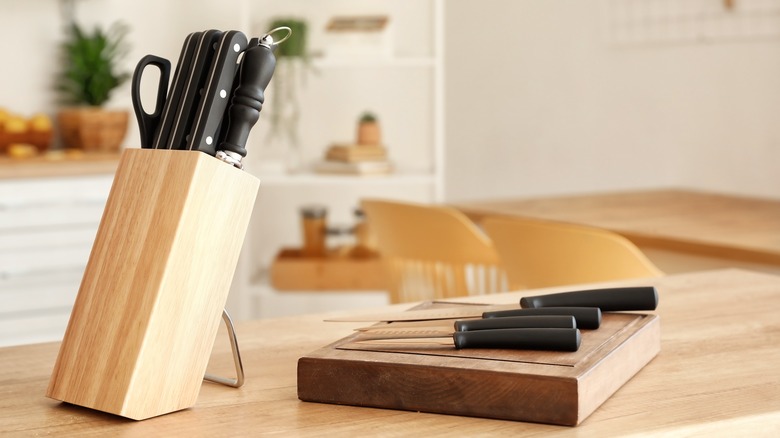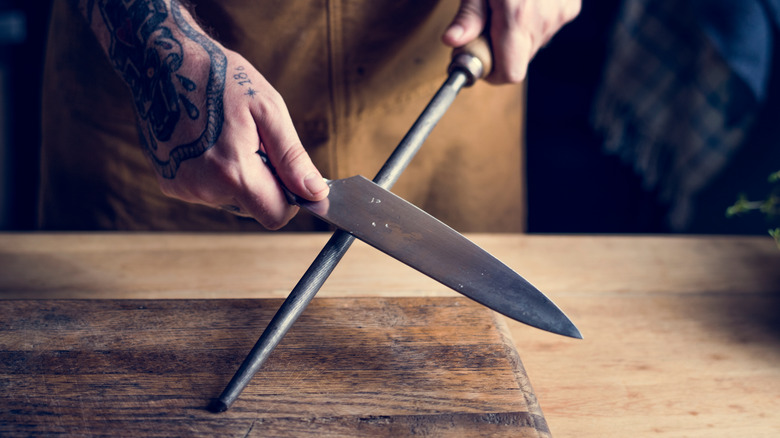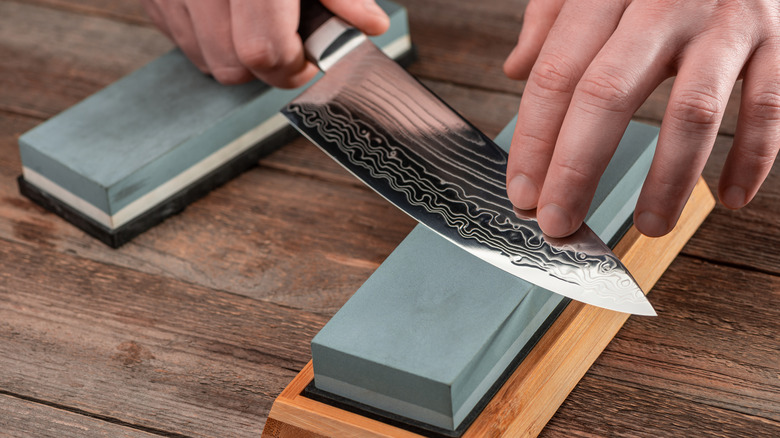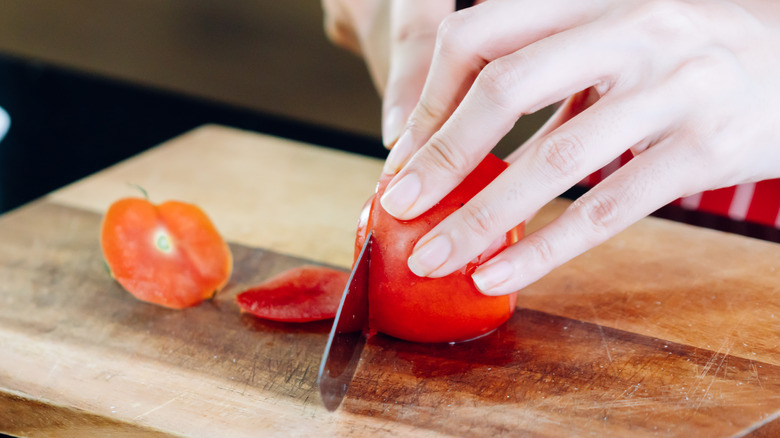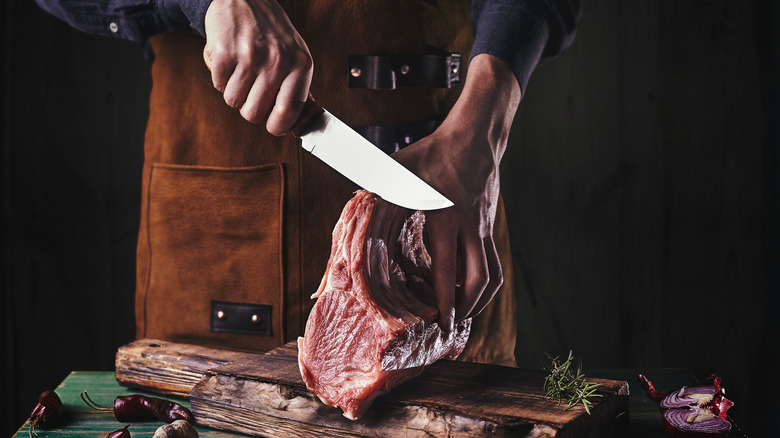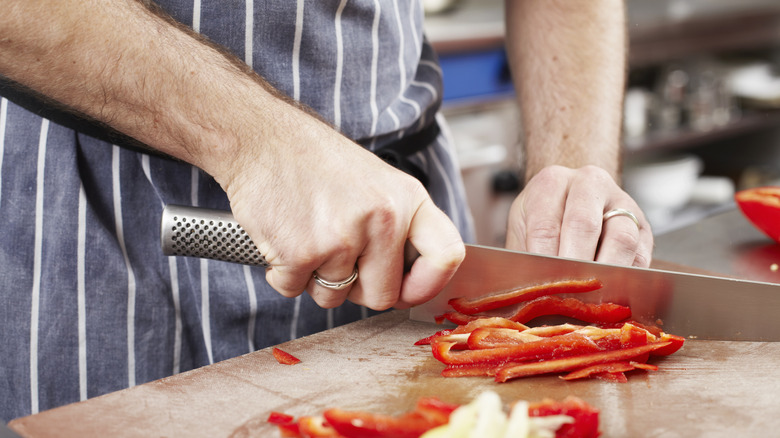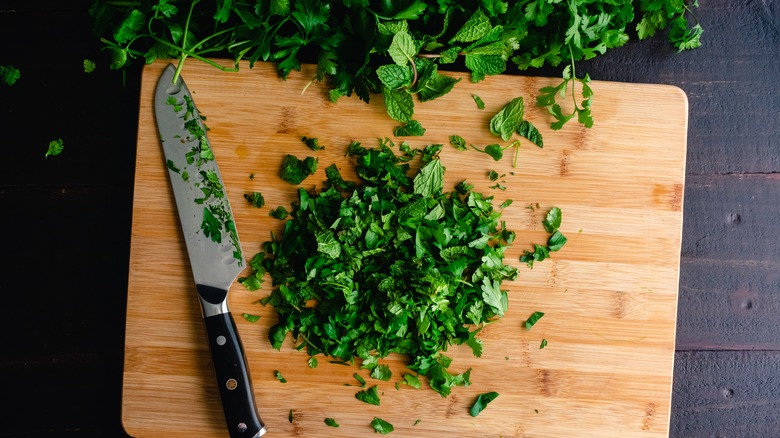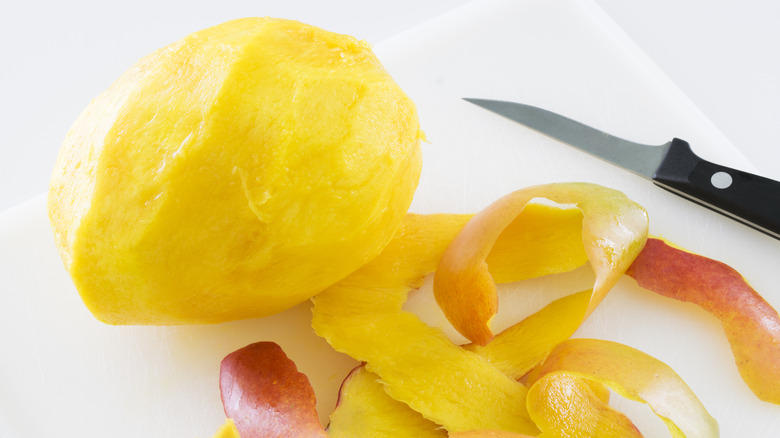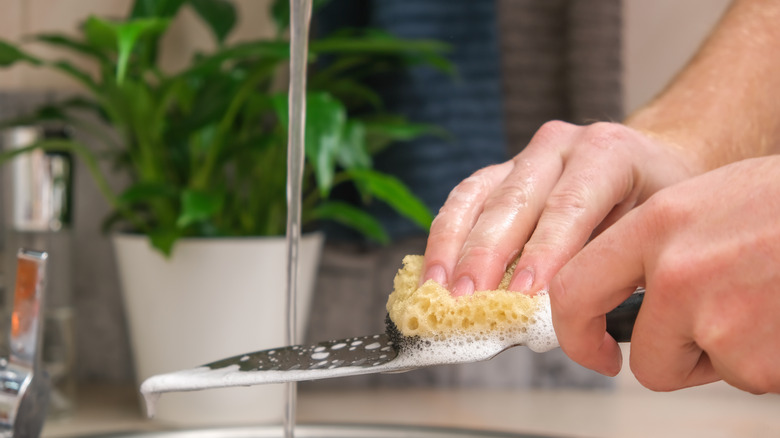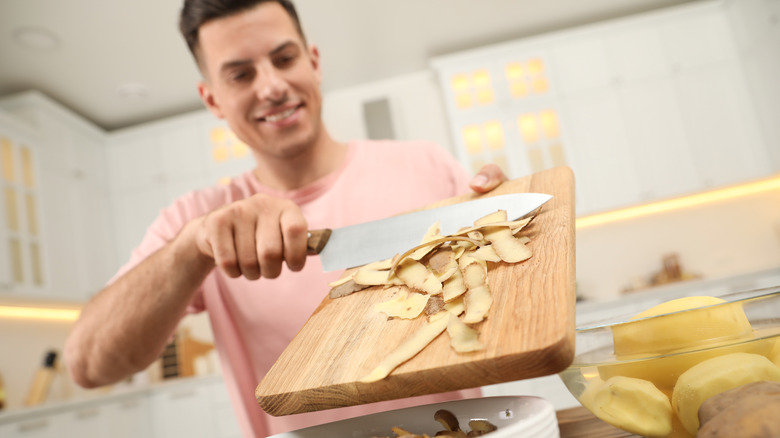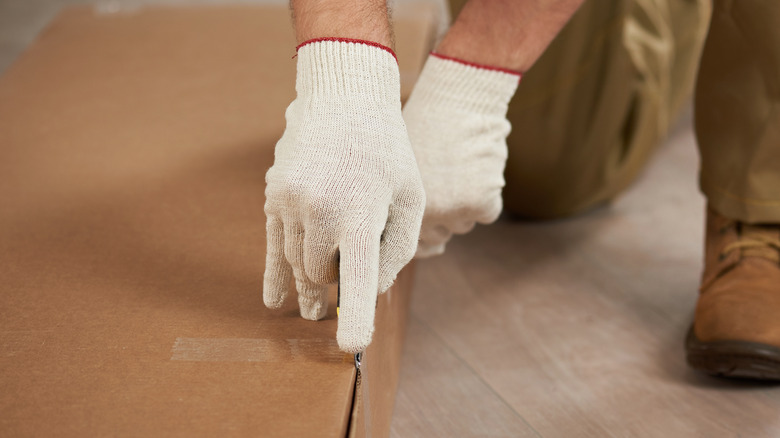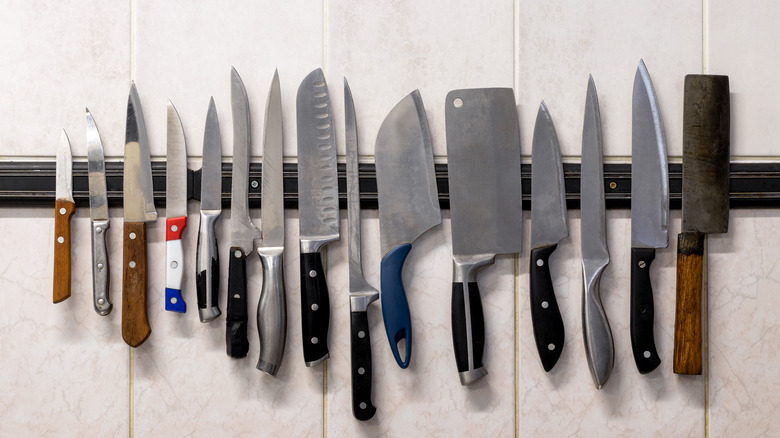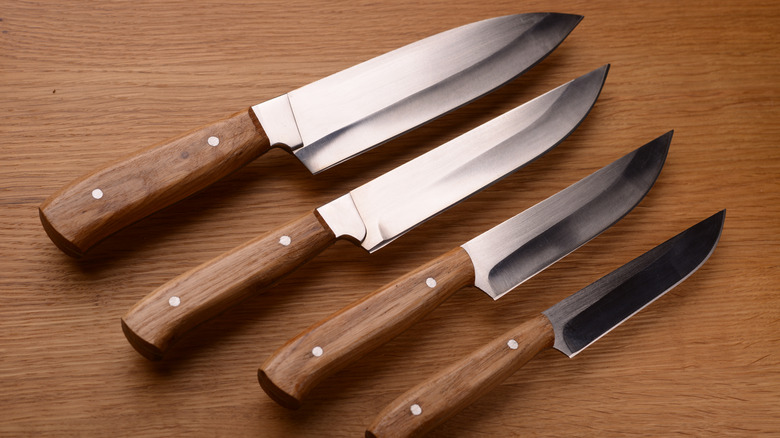The 12 Biggest Mistakes You're Making With Your Kitchen Knives
Whether you spend a lot of time in the kitchen cooking three meals a day or only cook an occasional Sunday dinner or holiday meal, you want to keep your favorite tools and utensils in good shape. Moreover, you want to be able to use these tools to their full ability to simplify your time in the kitchen. Some of the most essential items found in any kitchen are the kitchen knives. We use knives for so many cooking and food prep tasks, including cutting raw meat, chopping vegetables for soups, stews, and snacking, deboning fish, cutting roasts before serving, slicing bread, and so much more.
There are several mistakes that are commonly made when using kitchen knives. Some of these mistakes can even lead to serious injuries. A study published in the Journal of Emergency Medicine found that an average of 1,190 knife injuries occurred every day from 1990 through 2008. Learning more about common mistakes that people make with their knives can help you decrease your risk of injury, while also extending the lifespan of your knives and helping you make more efficient use of your time in the kitchen.
Not honing them
Many people know that knives need to be sharpened (and we'll get into more information about that in a moment). However, not everyone knows that they should also be honed. And, some don't even know what honing a knife even means. While sharpening actually gets rid of some of the metal on the knife's blade, giving it a new edge that is no longer dull, honing is a process that realigns the existing edge/blade of the knife.
Knives should be honed much more regularly than they're sharpened — approximately every third use. Keeping up with this schedule will help ensure that your trusty kitchen tools do a better job meeting the demands of each cutting task. They'll also feel sharper when you work with them. To hone a knife, simply pass it over a honing steel a few times every week (or less frequently if you rarely use the knife).
Remember, honing doesn't actually sharpen the blade. So, it won't do anything to help an already dull blade. For that, you'll want to keep reading the next section to learn more about how and when to properly sharpen your knives.
Not sharpening them
While knives should be honed every few uses, they don't need to be sharpened as often. Depending on how much you use your knives, you should sharpen them every six months to one year. If you're not sure whether your knives need to be sharpened, you can perform a quick test by trying to slice a ripe tomato. If the knife easily cuts through the tomato and doesn't crush it or shred the skin, then it is sharp. If you have trouble getting a clean cut or end up with a tomatoey mess, then it means that your knife is dull.
When a knife is sharpened, bits of metal are removed from the blade. The process results in a completely new edge on the blade that will deliver cleaner and safer cutting results. There are several ways to sharpen your knives at home, including using an electric sharpener, manual sharpener, or sharpening stone. While electric sharpeners are the quickest and easiest to use, they can cause the blade to degrade much more quickly, resulting in a shortened lifespan. If you're not comfortable sharpening your knives yourself using one of the other approved tools, consider taking them to a professional knife sharpener near you a few times a year.
Trying to cut with a dull knife
Keeping up with a regular sharpening schedule is important. Trying to use a dull knife to cut food is another serious mistake people can make. A dull knife doesn't work as well as a sharp one, which will require you to exert more effort as you try to "saw" through food. However, this isn't even the biggest problem with using a dull knife to cut.
What many people don't realize is that a dull knife is more dangerous than a sharp one. This may seem counterintuitive; we think about the potential dangers of accidentally cutting ourselves on the blade of a very sharp knife. However, the reason cutting with a dull knife can be more dangerous is that because it is not very sharp, you'll have to exert much more force to get it to slice through foods, particularly those that are harder. When you combine this additional force with the fact that the blade isn't sharp enough to nicely slice through the food item, it becomes more likely for the knife to slip. Depending on how it slips, it could knick one of your fingers or another nearby body part. You could even potentially lose your grip on the knife, causing it to fall towards your feet or another person working nearby.
Not choosing the right knife for each cutting task
While we all may have our go-to knife, it is important to make sure that the knife you choose matches the demands of the specific cutting task. Every kitchen should have a good assortment of knives so that you'll always have the right tool for the job. Some knives are definitely more versatile than others, but there will still be times when you need a more specialized knife. Let's take a look at some of the different types of knives you'll want in your knife block.
If you were to have only one knife (which we still don't recommend), it should be a chef's knife. This versatile tool can help with a wide assortment of tasks in the kitchen. From slicing or chopping fresh vegetables, cutting chunks of meat or even breaking through the joint, crushing fresh garlic, or slicing roasts, chef's knives are a true power horse. However, while you'll use your chef's knife a lot, it just isn't going to cut it (pun intended) for some tasks, so you'll want to expand your collection a bit.
You should also make sure your collection includes a paring knife. While a chef's knife has an 8- to 10-inch blade, a paring knife's blade is only about 3 inches long. This shorter blade is much better for more precise tasks or cutting smaller items, such as removing the stems from strawberries, peeling fruits, slicing mushrooms, or deveining shrimp. In addition to the paring knife, make sure you also have a serrated knife. The serrated blades make it much easier to cut through tomatoes and softer fruits without squishing them. You can also use a serrated blade to cut through some thicker items, such as sandwiches.
While there are many other types of knives, let's add one more to the essential category: a bread knife. With their saw-like blades, bread knives are ideal for cutting through loaves of bread and other baked goods without smashing the item. Bread knives have a very long blade (often longer than 10 inches), which makes them useful for slicing large loaves of bread or layer cakes. You can even use a bread knife to cut chocolate or large fruits, like pineapples or melons.
Not holding them correctly
Knowing which knife to use is only part of the battle. Another common mistake people make is not holding their knives correctly. If you aren't holding the knife correctly, you won't be able to use it as efficiently in the kitchen. An improper grip can also make accidental injuries more likely.
There are actually a few different ways that are considered correct when holding a knife. Depending on your experience, comfort level, and what you're cutting, you can decide which of these grips is best for you. One grip option is called a handle grip. As you can guess, this grip involves holding the handle of the knife. With it, the user's fingers will stay behind the bolster of the knife the entire time. Many beginners prefer this grip because it feels safer. However, you won't see too many professional chefs using it because it isn't as efficient or precise.
Another way to properly hold a knife is by using a pinch grip. This type of grip — which involves holding the blade of the knife between the forefinger's knuckle and the thumb (pinching it), with the rest of the fingers resting beneath the handle — offers greater control over the knife. When you use it to cut, it is easier to use a rocking method to efficiently and quickly cut up foods.
Beyond choosing a safe and appropriate grip for the hand in charge of cutting with the knife, it is also essential to know what to do with your other hand that is holding the food you are cutting. Obviously, if you're not holding it correctly, your fingers could inadvertently get cut. Use a claw grip where you bend your fingertips back, away from the sharp blade, to protect them.
Not using the right cutting surface
Did you know that it not only matters what you cut with and how you hold it, but also where you are cutting? Cutting on the wrong surface can cause a knife's blade to become dull more quickly than using the right surface. The reason some surfaces can dull a blade more quickly than others has to do with hardness — both of the cutting surface and of the steel blade. Granite, ceramic, glass, and marble are all harder than steel. Therefore, using a cutting board made of one of these materials can cause the knife to become dull more quickly.
The best cutting board material is wood. Not only is wood soft enough that it won't dull the blades on the knife too quickly, but it can also be an attractive addition to your kitchen. However, there are some downsides to wood cutting boards. They require oiling and special cleaning and can cost a pretty penny. Plastic is a good alternative to consider if you want to avoid dulling your knives when you cut, but also don't want to spend too much money.
Not cutting with the right part of the blade
Believe it or not, you can also make a mistake by using the wrong part of the blade when preparing food. When most of us think about using a knife in the kitchen, we are picturing using the edge of the blade to cut through various foods. However, the edge is just one part of the blade; each of the other parts of the blade can also come in handy in the kitchen, but you'll need to know what they are and how to use them.
Let's start with the edge since it is more familiar to everyone. The edge is the sharp part of the blade, and as you know, it can be used for slicing, dicing, and cutting items. Another important part of the blade is the tip. This pointy part of the knife is ideal for performing more precise or delicate tasks. For example, you would want to use the tip of a paring knife to help you remove the hulls from strawberries or the veins from raw shrimp.
Knife blades also have what's called a heel. Located on the back of the knife right below the handle, the part can be useful when trying to cut through harder food items, such as carrots. The spine — opposite the edge — is the smooth top surface of the knife. While it isn't sharp and useful for cutting, it is helpful for sliding foods off of the cutting board and into a bowl or pot. Finally, there is also a part called the flat. As the name suggests, this part is flat (knives have two of them). It can come in handy when you need to crush garlic or ginger.
Not washing and drying them correctly
It can be so tempting to just toss your knives in the dishwasher to simplify cleanup. However, doing so would be a mistake. When you wash knives in the dishwasher, you expose them to prolonged high temperatures and moisture. Neither of these is good for the knife and may result in rust, duller blades, or cracks in the handle.
Rather, knives should be hand washed — ideally immediately after they are used. Prompt cleaning removes food debris and prevents it from getting stuck on the blade or damaging it. When cleaning knives, use just a soft sponge with some soap and warm water. Do not opt for steel wool or other abrasive cleaners as they could damage the blade. Be sure to hold the blade away from you to avoid accidental injury when cleaning it.
After you've finished cleaning the knife, use a dish towel to dry it. If the knife is left to air dry, you are increasing the chances of rust forming. Air drying a knife may also allow more germs or bacteria to grow on the blade.
Using the edge of the blade as a scraper
Have you ever finished chopping up a big batch of vegetables for soup and used the edge of the blade to scrape them into the pot? If so, you've been guilty of another common mistake people make with their knives. While it may be convenient to simply run the edge of the knife across the cutting boards to clear off the foods you just chopped, doing so can cause the blade to dull more quickly.
Instead of using the sharp edge of the blade, you can flip it over and use the spine for this task. This will still allow you to quickly clear your cutting board and move on to the next task, but it won't risk damaging and dulling the blade. Alternatively, you can purchase food scrapers specifically designed for this task. Some are even designed to work like a scoop, allowing you to pick up and move cut veggies and other items from your cutting board to a pot or bowl.
Using the knives to do something other than cutting food
Your kitchen knives are for cutting food. Period. While they may be the sharpest thing in reach when you need to cut through something else, don't do it. That means that if you've been using your kitchen knives to cut the tape off of a shipping box, slice through ribbon or twine, or pop open a bottle, it is time to quickly change your ways. All of these actions, along with any other strange ways you've come up with to use your knives, pose a whole host of potential problems.
First, you are risking damaging or dulling the blade. Kitchen knives are designed to cut through food; they are not meant to be used for other tasks. Because the knives are so sharp, you are risking hurting yourself or others when you do not use them correctly. The knife could easily slip if you try to cut something you shouldn't. Moreover, think about all of the germs that you are potentially introducing into your kitchen when you use your knives to cut something like a package that has been handled by so many people and tossed on the ground outside.
Not storing them properly
If you want your knives to last for a long time and maintain a sharp blade for as long as possible, then it is so important to store them properly. Some people just throw caution to the wind and keep all of their knives in a jumbled heap in a drawer. Not only will this make it more likely for the blade to become dull, but you're playing Russian Roulette by risking injury every time you reach into the drawer.
There are three main options when it comes to storing your knives in a way that will protect the blades and your fingers. The first is to use a countertop knife block. These wood or bamboo blocks are designed with a variety of slots to hold different knives, keeping the handles easily accessible and the blades safely out of reach. Similarly, you can also purchase drawer inserts with slots to hold each knife. Like a knife block, these provide a dedicated space for each knife and keep the blades away from one another and fingers.
If you find yourself reaching for your knives frequently or are proud of your high-end collection, consider a magnetic storage strip. You can mount these strips against the wall, which will also help clear up drawer space in the kitchen. The powerful magnets hold onto the blade of each knife until you're ready to use it.
Not investing in high-quality kitchen knives
This final mistake doesn't have to do with how you handle or take care of your knives, rather it has to do with the quality of the knives you purchase. As with other kitchen essentials, knives are available at a range of price points. However, all knives are not created equally, and, in most cases, the cheaper options are not going to be able to match the quality of a more expensive knife.
One of the biggest differences between a cheap knife and a more expensive knife comes down to the material of the blade. While all knives have a steel blade, some grades are not as durable or long-lasting as others. When purchasing knives, look for ones with a stainless steel blade. They'll last longer and stay sharper longer than other knives.
If you've held a professional knife, you probably already know how nice it feels in your hand. More expensive knives offer a more comfortable handle than their cheaper counterparts. However, possibly more important, they're also better balanced for a better overall cutting experience. A lot more attention is paid to the weight and design of these knives than cheap options, which can have a big impact on how the knife will perform in the kitchen.
